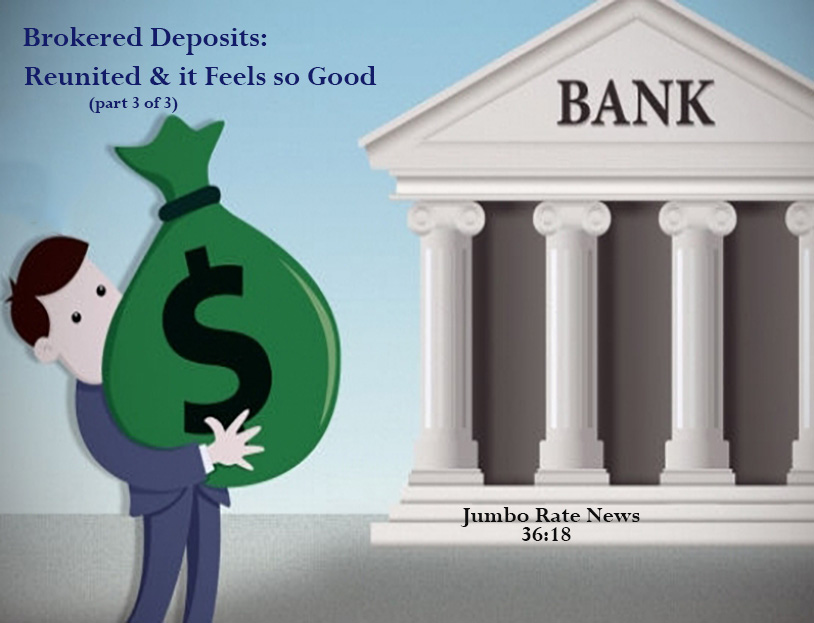The comment period is officially over and we don’t really know yet what the outcome will be. But, based on the comments, which are available to the public we can make an educated guess.
The Dodd-Frank Act directed the FDIC to conduct a study of brokered and core deposits, which it completed in 2011. A 2017 update confirmed the results—higher brokered deposit use is associated with higher probability of failure and higher losses to the deposit insurance fund. Three reasons were cited and are now debunked:
1) Rapid Growth—Rapid growth is not bad by itself. When it can become bad is if that growth is used to make risky loans. Then it can be lethal. Growth in and of itself is normal and desirable. So the argument to this is: why would you limit the growth instead of the risky lending?
2) Volatility—Historically, brokered deposits have tended to be much less stable than core deposits. Brokered deposits are generally just looking for the best yield, whereas a checking account, for example, is more likely to remain where it was opened. It’s simply a matter of convenience. Again, this is not dangerous as a rule, but if a bank relies too heavily on fleeting deposits, it can be. With the advent of internet banking, however, convenience has a new definition.
3) Franchise Value—This value of the bank (or franchise) only comes into play in the event the bank fails or is sold. Brokered deposits do make a bank less appealing for prospective buyers, which can mean higher losses for the insurance fund if it does fail.
We all remember the Indymac Bank failure (7/11/2008). (How can we forget?) Indymac accelerated its use of brokered deposits as its financial troubles began to grow. At the close of 2005, IndyMac had $1.4 billion in brokered deposits representing 18.4% of its total deposits. By 3/31/2008, its brokered deposits had swelled to $5.5 billion or 29% of total deposits.
As of 12/31/2017, estimated losses to the DIF from the IndyMac failure reached $12.3 billion!
But let’s not forget that it was remarks by Sen. Chuck Schumer (D-NY) that led to a deposit run at Indymac (and ultimately its failure). Over $100 million in deposits flew—core as quickly as brokered as people stood in long lines. Indymac was undoubtedly having problems. Would it have survived? We’ll never know. What we do know is that finding a buyer without government assistance would be impossible.
Without a doubt, we have come a long way since 2008. Our regulations have to keep up with changing times. Here are just a few clips from over one hundred comments submitted:
“I have always been a believer in Brokered Deposits as a very efficient means of re-allocating deposits from where they are located to where they are needed…
…quality loans are available in Iowa, however, we need a means to fund those loans.
Currently, we have around $50 million in Brokered Deposits funding our assets. Every year, as loan demand remains strong and deposits leave Iowa, our level of Brokered Deposits is always increasing.”
– David Woodcock, CEO
5-Star Farmers Trust, Spencer, IA
____________________________________________________________
“The use of brokered deposits as a liquidity tool should be considered directional depending on the use of the deposit by the specific institution. It seems clear that a bank that is trying to grow out of a problem has significantly different risk profile than one that is attempting to shrink in order to maintain capital ratio levels and reduce risky asset acquisition opportunities.”
– Chris Donnelly, President and CEO
5-Star Bank of the Prairie, Olathe, KS
____________________________________________________________
“The problem is not so much where banks get their money, but what they do with it once the get it. As long as prudent investment/loan strategies are followed, the concern over where the money comes from shouldn’t dictate and increased risk portfolio by default. Money is money. A liability is a liability. Does it really matter whether the customer we borrow it from came to us through our front door, or saw our rates with a listing service on the Internet?”
– Jamie Waller, President
4-Star Peoples Bank, Magnolia, AR
____________________________________________________________
As you can see, the clips we chose are from well-rated, well-respected community banks. Brokers, that may have compounded the S&L crisis in the 1980s, could be the saviors of these community banks today. The 50 banks on page 7 seem to believe that brokered deposits will no longer be frowned upon. None had any brokered deposits a year ago.

